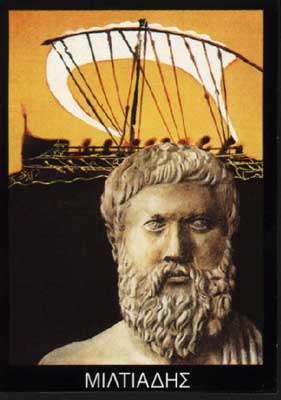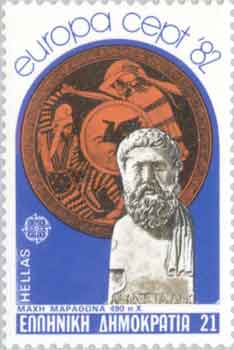
Miltiades the Younger ( Μιλτιάδης)(c.550 BC489 BC) was the step-nephew of Miltiades the Elder. He made himself the tyrant of the Greek colonies on the Thracian Chersonese around 516 BC, forcibly seizing it from his rivals and imprisoning them. He also married Hegesipyle, the daughter of king Olorus of Thrace. Their son Cimon was a major Athenian figure of the 470s and 460s BC.
He became a vassal of Darius I of Persia, joining Darius' expedition against the Scythians around 513 BC. He joined the Ionian revolt of 499 BC against Persian rule, establishing friendly relations with Athens and capturing the islands of Lemnos and Imbros (which he eventually ceded to Athens). However, the revolt collapsed in 494 BC and in 492 BC Miltiades fled to Athens to escape a retaliatory Persian invasion. His son Metiochos was captured by the Persians and made a lifelong prisoner, but was nonetheless treated honourably as a de facto member of the Persian nobility.

Arriving in Athens, Miltiades initially faced a hostile reception for his tyrannical rule in the Chersonese. However, he successfully presented himself as a defender of Greek freedoms against Persian despotism and escaped punishment. He was elected to serve as one of the 10 generals (strategoi) for 490 BC. He is often credited with devising the tactics that defeated the Persians in the Battle of Marathon later that year.
The following year, 489 BC, Miltiades led an Athenian expedition of 70 ships against the Greek-inhabited islands that were deemed to have supported the Persians. The expedition was not a success. The fleet attacked Paros, which had been conquered by the Persians, but failed take the island. Miltiades suffered a bad leg wound during the campaign and became incapacitated. His failure prompted an outcry on his return to Athens, enabling his political rivals to exploit his fall from grace. Charged with treason, he was sentenced to death, but the sentence was converted to a fine of 50 talents. This was a huge and unaffordable sum by the standards of the time. He was sent to prison where he died, probably of gangrene from his wound.
Elpinice daughter of Miltiades
Reference
Hammond, N.G.L., Scullard, H.H. eds.,Oxford Classical Dictionary, Second Edition; Oxford University Press 1970; ISBN 0198691173
Photo essay of Miltiades helmet - found in Olympia and identified by an inscription
http://www.livius.org/mi-mn/miltiades/miltiades.html
|
Athenian statesmen | Ancient Greece Aeschines - Agyrrhius - Alcibiades - Andocides - Archinus - Aristides - Aristogeiton - Aristophon - Autocles Callistratus - Chremonides - Cleisthenes - Cleon - Critias - Demades - Demetrius Phalereus - Demochares - Democles - Demosthenes Ephialtes - Eubulus - Hyperbolos - Hypereides - Kimon - Kleophon - Lycurgus Miltiades - Moerocles - Nicias - Peisistratus - Pericles - Philinus - Phocion - Themistocles |
Retrieved from "http://en.wikipedia.org/"
All text is available under the terms of the GNU Free Documentation License
| Ancient Greece
Science, Technology , Medicine , Warfare, , Biographies , Life , Cities/Places/Maps , Arts , Literature , Philosophy ,Olympics, Mythology , History , Images Medieval Greece / Byzantine Empire Science, Technology, Arts, , Warfare , Literature, Biographies, Icons, History Modern Greece Cities, Islands, Regions, Fauna/Flora ,Biographies , History , Warfare, Science/Technology, Literature, Music , Arts , Film/Actors , Sport , Fashion --- |

